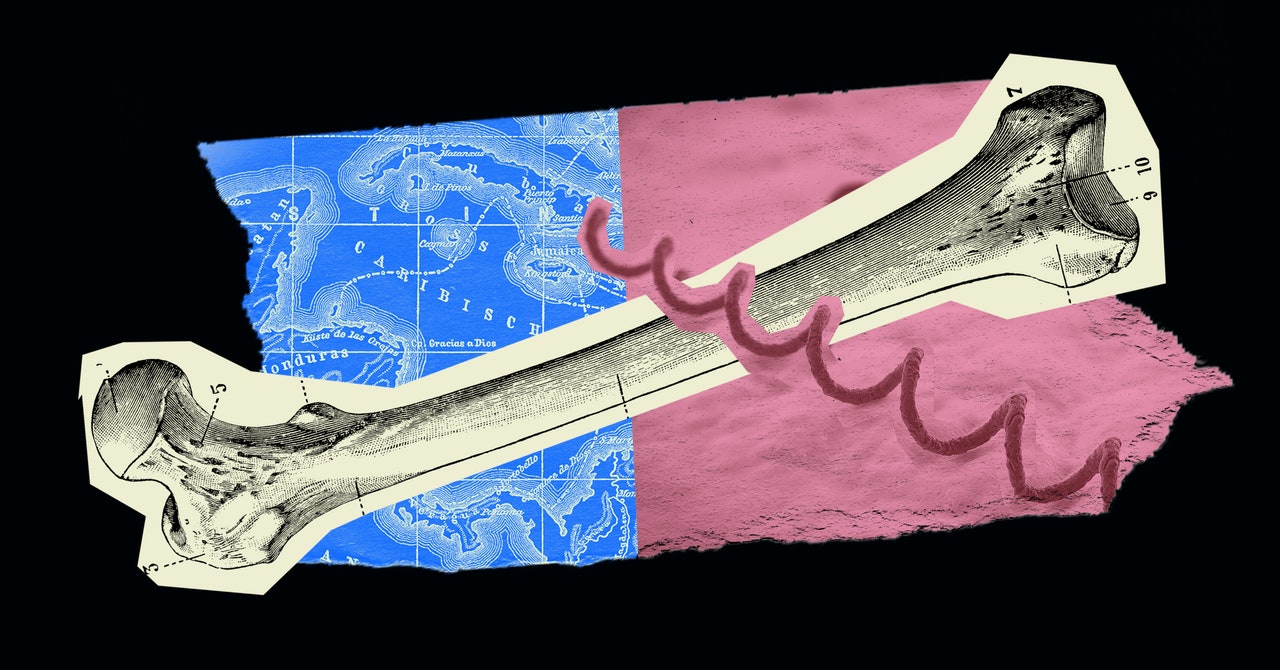
Using an unblemished femur from the same burial site as a control, his lab extracted degraded DNA present in the bone, sequenced it, and identified strings of nucleotides that resembled portions of reference genomes for T. pallidum. The group verified the sequences’ identities by generating a kind of family tree that linked the found sequences to known ones. (They did not find intact bacteria.) They also looked for the shadow of the victim’s reaction to the pathogen. After crushing and liquefying a small portion of bone, they hunted for antibody proteins that would have been produced in response to infection and then carried into the bone by the bloodstream, a process they dubbed “paleoserology.”
“For me, it was not enough to prove that this femur contained some pieces of Treponema pallidum,” Drancourt says. “It was necessary to prove that the guy did develop, centuries ago, an inflammatory immune response against this Treponema. And when you have both, then you have the disease.”
Not everyone agrees. “Although the publication frequently implies that their findings are about syphilis, that is not true. Their findings relate to treponemal infection,” Sheila Lukehart, a syphilis expert and emeritus professor of medicine and global health at the University of Washington, told WIRED by email. “It is quite possible, maybe likely, that the organism in their examined femur is a pertenue rather than a pallidum subspecies.” (If so, it would mean that the victim suffered from yaws, not syphilis.)
Though the possibility of syphilis being present in Europe so early could change the scientific understanding of the disease, it might not rewrite its competing histories. At least, not yet. “Historians look at texts,” Siena says. “There’s a whole host of historians who are uneasy even talking about syphilis before the age of blood tests, because they don’t want to do retro-diagnosis—this notion that you could diagnose a disease hundreds of years after the fact based upon descriptions.”
When historians look at the archival record, they cannot find evidence that syphilis epidemics resembling those of the late 1400s occurred before that date. If the organism was in Europe then, or imported periodically by traders, did it create lesser symptoms? Were infections masked by being attributed to another more-feared disease, such as leprosy? Did the bacterium adapt as towns grew larger and people migrated from the countryside, changing the ways they lived and interacted sexually?
Or did Columbus, in a twist on the established story, in fact carry something home—not an entirely new disease, but a variant of an existing one, more lethal and more reproductively fit? Today, it’s understood that syphilis infection does not create durable immunity; someone who has been infected once can become infected again. Even if Europeans had been exposed to an earlier strain of the disease, that might not have protected them against a fresh, virulent version.
In that scenario, both versions of the history of syphilis—one that begins before Columbus and one that starts after—can simultaneously be true. And in that scenario, Columbus and his Spanish sponsors do not evade responsibility for infecting Europe, something that could be viewed as the Americas’ revenge for their exploitation.
He may not have escaped their revenge anyway. “There is some thought that Columbus had syphilis,” says Erin Stone, an associate professor of history at the University of West Florida who studies colonial Latin America. “In his fourth voyage, he writes a very long journal entry about how the world is not round, but pear-shaped, with a nipple at the center, and he has sailed around it. A lot of documents point toward him not being in his right mind toward the end of his life.”
Columbus died in 1506, at age 54, after years of attacks of fevers and joint pains that left him temporarily blind and occasionally bedridden. He has been diagnosed retrospectively with gout, autoimmune conditions, and reactive arthritis, which is caused by a foodborne illness or several sexually transmitted infections. Where his bones lie is disputed. They have never been tested for disease.


